Lucius Septimius Severus
CommonName: Septimius Severus
FullName: Lucius Septimius Severus
Reign: 193-211 AD
Title: Emperor
Born: 145 AD
Died: 211 AD
Relationship: Governor of Pannonia Superior
Lucius Septimius Severus was a native of Lepcis Magna in North Africa.At
least some of his family was of Punic extraction. Severus himself served
as governor of Lyonnais Gaul and Sicily, being appointed governor of Lower
Pannonoa, with its legions, in 190. In 193 after the murder of Pertinax
and the infamous auction Severus was proclaimed emperor by his troops,
and in the following civil war defeated first Niger, then Albinus, reorganizing
the provinces so as to make further rebellions more difficult.
His rule was harsh, and he certainly favoured the soldiers. He immediately
disbanded the Praetorians on his arrival at Rome, regarding the deakl with
Julianus as disgraceful, but still more disgraceful was their failure to
keep their part of the bargain. He replaced them with men from his legions,
who were devoted only to him, without any connections with any in Rome.
He married Julia Domna, daughter of the priest of the god Elagabalus
at Emesa, in Syria. According to the story, Severus, who was fond of astrology
and other arts of that kind, heard that her horoscope said that she would
be the wife of a king. Evidently Severus decided that he was as good a
candidate as any, and married her. Severus also consulted oracles, prophetic
books and the like, regardless of the natioanlity, whether in Syria, Egypt
or elsewhere.
Severus promoted a distant relative and fellow African, Plautianus,
as his praetorian prefect. This man became a sort of second Sejanus, becoming
de facto emperor. He insisted on having Severus's son Caracalla marry his
daughter Plautilla; Caracalla was not exactly overjoyed. Bad as he was,
she seems to have been worse.
Caracalla resented anyone else's advancement, and he engineered Plautianus's
downfall and assassination in 205. A reign of terror followed, where all
the usual accusations, true and false, brought the usual crop of victims.
Partly as a result of this one Bulla got a band of robbers together and
terrorized much of Italy. He caught a centurion attempting to catch him;
he sent the man home with the message: "Feed your slaves if you don't want
them becoming robbers"; particularly apt when his army consisted largely
of imperial freedmen who had been owed large arrears of pay.
In 208 Severus had to travel to Britain to deal with marauding hordes
of Caledonians from Scotland. He decided to conquer the territory, but
found that the Caledonians refused to fight a pitched battle, but harassed
his army from forests, swamps and mountains. He traveled the length of
the country, losing many men, gaining nothing, and in the end he was content
to settle for nominal submission.
When they rebelled again the following year Severus set out to destroy
the country, but fell ill and died in York. His last words to Caracalla
were: Get along with your brother, be generous to the troops, and care
nothing for anyone else". He was best described as being "very cruel, and
very useful".
---------------------------------------------------------------------------------------------------------------------------------------------------------
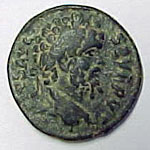
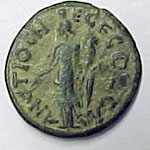
SEPTIMIUS SEVERUS AE 22, Pisidia, Antiioch, 4.93g, Krzyzanowska Av.
XXII/Rv. 36 (pl.XIII, p. 153), Rx: Pax as "Genius of the Colony" standing
l. holding branch and cornucopia, VF, attractive
---------------------------------------------------------------------------------------------------------------------------------------------------------
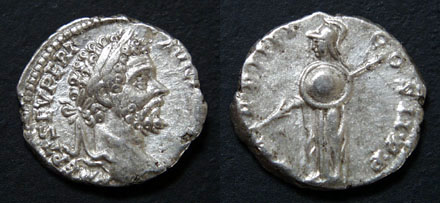
SEPTIMIUS SEVERUS, 193-211 AD. AR Denarius (3.09 gm), 196/7. Laureate
head / Minerva standing with spear and shield. RSC.416. VF+.
---------------------------------------------------------------------------------------------------------------------------------------------------------

Thrace, Augusta Traiana (Trajanopolis). Septimius Severus. 193-211
AD. Æ 24mm laureate head right / Retrograde legend, Agathodaimon
serpent coiled right. SNG Copenhagen -; BMC Thrace, etc. -; Mionnet Supp.
II pg. 509, 799. Good Fine, black patina.
---------------------------------------------------------------------------------------------------------------------------------------------------------
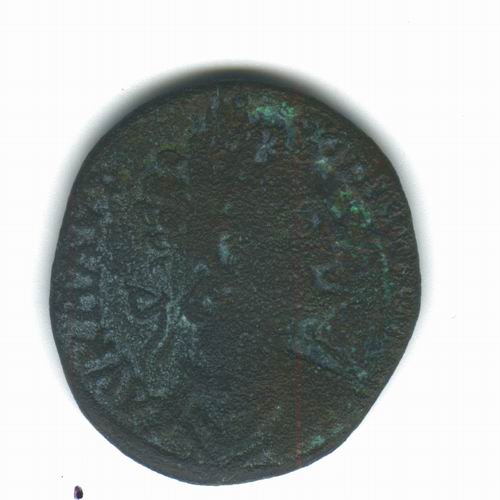

Anchialus, an AE27 of Septimius Severus, illustrates the other (much
less common) option for reverse legends in this series. The attribute of
the city 'Ulpian' was dropped in favor of naming the provincial governor,
legate or or other official under whose authority the coin was issued.
While seen on this Thracian issue, this practice will be shown to be more
common in Moesia. The reverse legend reads HG CT BAPBAPOV AGXIALEWN or
'of the Anchialans during the time of legate Statius Barbarus'. HG abbreviates
the legate's title Hgemoneuontos. The reverse type shows the gates of the
city. The fact that this coin is from early in the reign is suggested by
the portrait style and obverse legend (more easily seen on the coin than
on my poor photo) ending in P abbreviating Pertinax which was used by Septimius
only during the first five years of his reign.
---------------------------------------------------------------------------------------------------------------------------------------------------------

Moesia Inferior, Markianopolis. SEPTIMIUS SEVERUS & JULIA DOMNA.
AE 27 mm. Confronted busts of Septimius & Domna. / Cybele enthroned
left, flanked by lions, holding patera and restingon drum.
---------------------------------------------------------------------------------------------------------------------------------------------------------
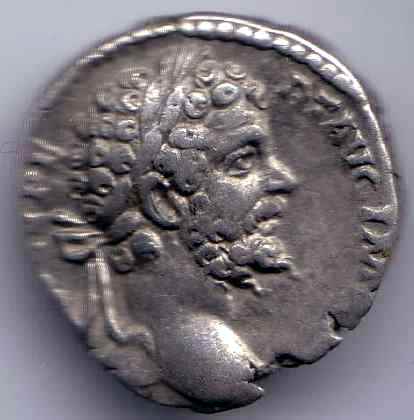
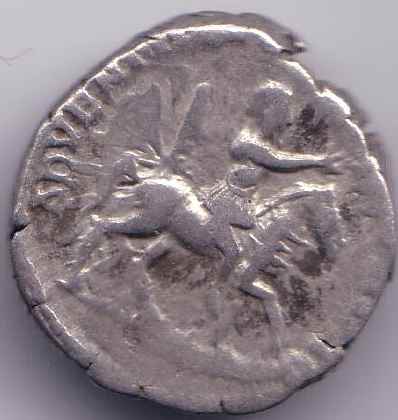
Silver denarius, RIC 74, RSC 6, gVF, 3.27g, 17.7mm, 180°, Rome
mint, 196-197 A.D.; obverse L SEPT SEV PERT AVG IMP VIII, laureate head
right; reverse ADVENTI AVG FELICISSIMO, Septimius in military dress riding
right on horseback.






